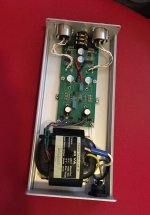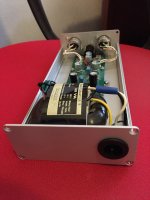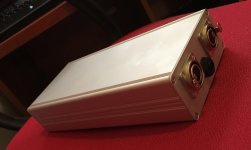Hello,
Currently i'm using The Wire SE-SE with ODAC but am considering a change.
What good and affordable DAC can you recommend guys? Would i get something better than ODAC at 150 or max 200 USD price point? Something from Emotiva, Centrance, HRT? I'm also open to DIY projects.
Currently i'm using The Wire SE-SE with ODAC but am considering a change.
What good and affordable DAC can you recommend guys? Would i get something better than ODAC at 150 or max 200 USD price point? Something from Emotiva, Centrance, HRT? I'm also open to DIY projects.
Any hint on how to fix this ?
Just out of curiosity if you want to try something, try putting 10 ohms in series between the output of the Wire and the headphone output jack on one channel and see if that nukes it, or at least reduces it. If not, try 20R instead.
Just out of curiosity if you want to try something, try putting 10 ohms in series between the output of the Wire and the headphone output jack on one channel and see if that nukes it, or at least reduces it. If not, try 20R instead.
With 12R I don't see any oscillation. Let's see if it last. I may add a 0.1uF in parallel. This should kill it completely and cut mostly above 100kHz
Thanks,
Hello,
Currently i'm using The Wire SE-SE with ODAC but am considering a change.
What good and affordable DAC can you recommend guys? Would i get something better than ODAC at 150 or max 200 USD price point? Something from Emotiva, Centrance, HRT? I'm also open to DIY projects.
How about building a 5v Sultzer supply for the odac? You'd put in a USB in and out on it, and inject the good 5 v to the output. You'd be able to use this with any of the other USB powered dacs. You can also buy something like this, but i think commercial ones are outside your budget. The Schitt Wyrd has been getting good write-ups -- at $100 it is not a supply, but just cleans up the USB power.
Last year I made few attempts to build a tube headphone amp using DHT's. For certain reason, I didn't get the sound that I wished for...and also the size made me abandon the project.
Browsing DIY Audio site, I was attracted by OPC's simple design of the "Wire" headphone amp. I've never build with SMD's before and I can say that the soldering was a little challenging. However, Owen's boards are very well made and everything worked at the first try.
I am very happy with the sound of this superb headphone amp. I am using it between my iPad and Sennheiser HD595 and I can tell that my listening experience was brought to a lovely level. The dynamics are excellent, dead quiet, channel separation is amazing, strong base, and very detailed mids and highs.
Thank you Owen. Happy Holidays!
Best,
Radu
Browsing DIY Audio site, I was attracted by OPC's simple design of the "Wire" headphone amp. I've never build with SMD's before and I can say that the soldering was a little challenging. However, Owen's boards are very well made and everything worked at the first try.
I am very happy with the sound of this superb headphone amp. I am using it between my iPad and Sennheiser HD595 and I can tell that my listening experience was brought to a lovely level. The dynamics are excellent, dead quiet, channel separation is amazing, strong base, and very detailed mids and highs.
Thank you Owen. Happy Holidays!
Best,
Radu
Attachments
-
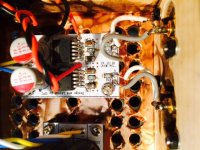 photo 3 (1).JPG145.3 KB · Views: 536
photo 3 (1).JPG145.3 KB · Views: 536 -
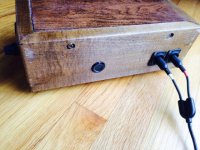 photo 2.JPG149.2 KB · Views: 187
photo 2.JPG149.2 KB · Views: 187 -
 photo 1.JPG121.7 KB · Views: 182
photo 1.JPG121.7 KB · Views: 182 -
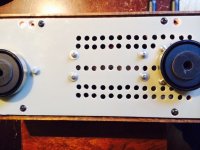 photo 4.JPG109.1 KB · Views: 182
photo 4.JPG109.1 KB · Views: 182 -
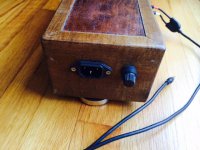 photo 3.JPG128 KB · Views: 221
photo 3.JPG128 KB · Views: 221 -
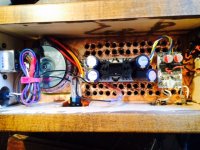 photo 5.JPG153.3 KB · Views: 492
photo 5.JPG153.3 KB · Views: 492 -
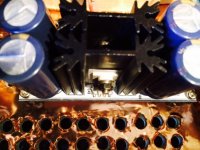 photo 2 (1).JPG127.1 KB · Views: 485
photo 2 (1).JPG127.1 KB · Views: 485 -
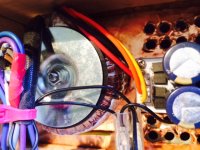 photo 1 (1).JPG142.9 KB · Views: 495
photo 1 (1).JPG142.9 KB · Views: 495 -
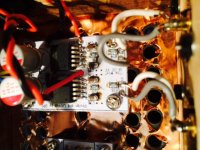 photo 4 (1).JPG138.3 KB · Views: 512
photo 4 (1).JPG138.3 KB · Views: 512
Beautiful implementation!
This is exactly how I always intended "The Wire" headphone amps to be used.
I've sullied mine with a stepped attenuator, but I plan to build one just like yours once my DAC is done 😉
Enjoy!
Owen
This is exactly how I always intended "The Wire" headphone amps to be used.
I've sullied mine with a stepped attenuator, but I plan to build one just like yours once my DAC is done 😉
Enjoy!
Owen
Glad you like it and thanks for making it happen!
I'm sure the DAC will meet the same standards, so I'm definitely looking forward to it. 😎
I'm sure the DAC will meet the same standards, so I'm definitely looking forward to it. 😎
Quick noob questions
Hello all
Could someone please help me by answering 2 quick questions:
1. I am an absolute beginner (electronics and soldering) and I just soldered my frist PSU (my first pcb at all, actually). The tiny smd-parts caused me a lot of sweating to be honest...😉. Anyways, it's finished now and I measured 14.91V on one side and 14.99V on the other. Is this level of accuracy sufficient or does the difference between .91 and .99 have to be smaller?
2. I am soldering a BAL-BAL now while waiting for some parts for the SE-SE version. Is it possible to wire up the BAL-BAL version as SE-SE?
If yes: can you tell me how to wire the inputs and outputs, please?
- Wiring of BAL-Outputs as SE-Outputs: usage of + from OUT and ground from PSU input?
- Wiring of BAL-Inputs as SE-Inputs: RCA-plus to input-terminal-plus and RCA-minus to input-terminal-ground and terminal-minus?
Thank you so much for your help!
Stephan
Hello all
Could someone please help me by answering 2 quick questions:
1. I am an absolute beginner (electronics and soldering) and I just soldered my frist PSU (my first pcb at all, actually). The tiny smd-parts caused me a lot of sweating to be honest...😉. Anyways, it's finished now and I measured 14.91V on one side and 14.99V on the other. Is this level of accuracy sufficient or does the difference between .91 and .99 have to be smaller?
2. I am soldering a BAL-BAL now while waiting for some parts for the SE-SE version. Is it possible to wire up the BAL-BAL version as SE-SE?
If yes: can you tell me how to wire the inputs and outputs, please?
- Wiring of BAL-Outputs as SE-Outputs: usage of + from OUT and ground from PSU input?
- Wiring of BAL-Inputs as SE-Inputs: RCA-plus to input-terminal-plus and RCA-minus to input-terminal-ground and terminal-minus?
Thank you so much for your help!
Stephan
Hi Stephan,
Generally, a slight deviation from the target of +/-15V is nothing to worry about.
Particularly, let's look at the numbers: 14.91V / 15V = 0,994.
So you have an actual level of 99.4%, thus an error of 0.6%.
That's really not too bad.
If we consider only the imbalance, the error is even smaller: 14.91V / 14.99V = 0.9947, thus an error of 0.53%.
But it would be interesting to know where the difference comes from.
Does your PSU version have a trimpot (i.e. version one, green board, as opposed to version two, white board)?
What component tolerances (predominantly of the resistors) did you use?
Did you heat the components on one channel significantly longer than those on the other channel?
Yes, that's one way. Actually, it doesn't matter which of the outputs you take. One is inverted, the other one isn't. That's about the only difference. You could even connect two SE headphones or amplifiers.
But keep in mind that the ground reference of the stage you're interfacing to has to be tied to the BAL-BAL's 0V/ground level, too.
Basically, yes. And again, you can use either the inverting or the noninverting inputs, as long as you tie the other one to 0V/ground.
But there's a lot to consider when interconnecting devices. Describing all of it would be going too far within this post, and some of it is also still going over my head.
But I like to recommend Rane Note 151 as a starting point, particularly figure 5 (note the different kinds of "ground"!).
Another overview can be found in Jensen AN003.
The topic as also been discussed on the forums before.
In other words: if you want to temporarily use unbalanced devices with the BAL-BAL, don't spoil the BAL-BAL, but tailor your interconnects instead. 😉
Cheers,
Sebastian.
I measured 14.91V on one side and 14.99V on the other. Is this level of accuracy sufficient or does the difference between .91 and .99 have to be smaller?
Generally, a slight deviation from the target of +/-15V is nothing to worry about.
Particularly, let's look at the numbers: 14.91V / 15V = 0,994.
So you have an actual level of 99.4%, thus an error of 0.6%.
That's really not too bad.
If we consider only the imbalance, the error is even smaller: 14.91V / 14.99V = 0.9947, thus an error of 0.53%.
But it would be interesting to know where the difference comes from.
Does your PSU version have a trimpot (i.e. version one, green board, as opposed to version two, white board)?
What component tolerances (predominantly of the resistors) did you use?
Did you heat the components on one channel significantly longer than those on the other channel?
Wiring of BAL-Outputs as SE-Outputs: usage of + from OUT and ground from PSU input?
Yes, that's one way. Actually, it doesn't matter which of the outputs you take. One is inverted, the other one isn't. That's about the only difference. You could even connect two SE headphones or amplifiers.
But keep in mind that the ground reference of the stage you're interfacing to has to be tied to the BAL-BAL's 0V/ground level, too.
Wiring of BAL-Inputs as SE-Inputs: RCA-plus to input-terminal-plus and RCA-minus to input-terminal-ground and terminal-minus?
Basically, yes. And again, you can use either the inverting or the noninverting inputs, as long as you tie the other one to 0V/ground.
But there's a lot to consider when interconnecting devices. Describing all of it would be going too far within this post, and some of it is also still going over my head.
But I like to recommend Rane Note 151 as a starting point, particularly figure 5 (note the different kinds of "ground"!).
Another overview can be found in Jensen AN003.
The topic as also been discussed on the forums before.
In other words: if you want to temporarily use unbalanced devices with the BAL-BAL, don't spoil the BAL-BAL, but tailor your interconnects instead. 😉
Cheers,
Sebastian.
Last edited:
Hello Sebastian
Thanks so much for your very helpful response! Will read up a bit on the "backgrounds to grounds" you kindly provided.
Meanwhile I wired up everything as described. One channel works - the other is dead...
Since it was my first soldering experience I am sure I overheated something. Also, on the non-working channel side I even managed to scratch one pad so much, it probably connected to a nearby resistor, or tehere might be no connection at all...so that explains it easily.
But no big deal, I have another spare Bal-Bal-board and a SE-version, too. I'll be more careful with them and also (I am dreaming now🙂 I slowly start to get a hang on it ("slowly" should be stressed).
To answer your questions:
1. PSU:
V2-version; all original parts from BOM V2 from mouser/DK; yes, I probably overheated one side even more than the other 😉 , but the result seems to be OK...although I used approximately 10kg of solder to virtually "bake" the whole board 🙂
2. "...don't spoil the BAL-BAL, but tailor your interconnects instead...":
I plan to build/buy a DAC with balanced OUTs in the near future to feed my amp/HP-amp. My amps (ablatec) can be fed with a balanced signal. Also, I will mod my headphone to be balanced, soon. So no worries on that end 😉
Thanks again for your help, Sebastian!
And I would like to thank Owen for making his outstanding projects available to everyone. This combined with his impressive support just amazes me!
Best regards
Stephan
Thanks so much for your very helpful response! Will read up a bit on the "backgrounds to grounds" you kindly provided.
Meanwhile I wired up everything as described. One channel works - the other is dead...
Since it was my first soldering experience I am sure I overheated something. Also, on the non-working channel side I even managed to scratch one pad so much, it probably connected to a nearby resistor, or tehere might be no connection at all...so that explains it easily.
But no big deal, I have another spare Bal-Bal-board and a SE-version, too. I'll be more careful with them and also (I am dreaming now🙂 I slowly start to get a hang on it ("slowly" should be stressed).
To answer your questions:
1. PSU:
V2-version; all original parts from BOM V2 from mouser/DK; yes, I probably overheated one side even more than the other 😉 , but the result seems to be OK...although I used approximately 10kg of solder to virtually "bake" the whole board 🙂
2. "...don't spoil the BAL-BAL, but tailor your interconnects instead...":
I plan to build/buy a DAC with balanced OUTs in the near future to feed my amp/HP-amp. My amps (ablatec) can be fed with a balanced signal. Also, I will mod my headphone to be balanced, soon. So no worries on that end 😉
Thanks again for your help, Sebastian!
And I would like to thank Owen for making his outstanding projects available to everyone. This combined with his impressive support just amazes me!
Best regards
Stephan
I already asked this on another thread, but since I got no answer, I dare to ask it here 😉
I was thinking about using Soekris R2R dac unbuffered outputs to a Wire BAL-BAL headphone amp with negative inputs of the OPA1632 grounded so it would do the single ended to differential conversion. (Figure 11 of OPA1632 datasheet page 7). It should be higher end than the included LME49710 + LME49724 for driving picky headphones requiring large current.
Did someone test this single ended to balanced conversion with the Wire BAL-BAL ?
My other concern is about the output impedance of the raw dac outputs versus input impedance of the Wire BAL-BAL.
Default input resistor of the Wire is 1 kohm, and raw dac output is 1.25 kohm.
Based on this post - I was wondering if 10kohm input resistor such as used in the calculation would be enough ?
I guess I should also try 1x gain and 2x gain due to the low level of the unbuffered dac output (1.2v)
I was thinking about using Soekris R2R dac unbuffered outputs to a Wire BAL-BAL headphone amp with negative inputs of the OPA1632 grounded so it would do the single ended to differential conversion. (Figure 11 of OPA1632 datasheet page 7). It should be higher end than the included LME49710 + LME49724 for driving picky headphones requiring large current.
Did someone test this single ended to balanced conversion with the Wire BAL-BAL ?
My other concern is about the output impedance of the raw dac outputs versus input impedance of the Wire BAL-BAL.
Default input resistor of the Wire is 1 kohm, and raw dac output is 1.25 kohm.
Based on this post - I was wondering if 10kohm input resistor such as used in the calculation would be enough ?
I guess I should also try 1x gain and 2x gain due to the low level of the unbuffered dac output (1.2v)
Single ended to differential conversion by grounding the inverting input works just great.
Keep in mind you may not need any gain because you already get 2x gain when you go from SE to balanced.
Keep in mind you may not need any gain because you already get 2x gain when you go from SE to balanced.
I already asked this on another thread, but since I got no answer, I dare to ask it here 😉
I was thinking about using Soekris R2R dac unbuffered outputs to a Wire BAL-BAL headphone amp with negative inputs of the OPA1632 grounded so it would do the single ended to differential conversion. (Figure 11 of OPA1632 datasheet page 7). It should be higher end than the included LME49710 + LME49724 for driving picky headphones requiring large current.
Did someone test this single ended to balanced conversion with the Wire BAL-BAL ?
My other concern is about the output impedance of the raw dac outputs versus input impedance of the Wire BAL-BAL.
Default input resistor of the Wire is 1 kohm, and raw dac output is 1.25 kohm.
Based on this post - I was wondering if 10kohm input resistor such as used in the calculation would be enough ?
I guess I should also try 1x gain and 2x gain due to the low level of the unbuffered dac output (1.2v)
Buy two DAC boards and run them in dual mono to get true differential output!
That is, if it's possible 😉
Otherwise, yes you can run SE into the BAL-BAL. I would change the resistors to 10K as you mentioned, and perhaps check with Soekris about the effects of loading the unbuffered output. 10k should be plenty high, but he may have other suggestions.
Regards,
Owen
Single ended to differential conversion by grounding the inverting input works just great.
Keep in mind you may not need any gain because you already get 2x gain when you go from SE to balanced.
Great news, thanks for your kind report.
I don't need the 2x gain for my headphones (TH-900), but I test lots of headphones, even those difficult to drive beasts (HE-6, K1000, Abyss ...).
Buy two DAC boards and run them in dual mono to get true differential output!
That is, if it's possible 😉
Of course! That was my first idea. I asked long time ago this very special feature to Soekris, and he accepted to include support for this feature. It's on his to do list after doing the digital crossover and the multichannel feature. So it's planned but it's not available yet.
So, I was thinking to order only one, test if I like the sound or not, and maybe going dual mono when it's finally available.
Otherwise, yes you can run SE into the BAL-BAL. I would change the resistors to 10K as you mentioned, and perhaps check with Soekris about the effects of loading the unbuffered output. 10k should be plenty high, but he may have other suggestions.
10K Seems a good value,
I ask on his topic first but he did not replied. He seems very busy.
it seems reasonnable to ask what he used for his LME49710 stage and do exactly the same thing for the Bal OPA1632.
Thanks for your kind answers and your excellent work Owen.
What do you think about AD797 in gain stage? I can buy them originals in good price. They might need compensation in feedback, right?
Wow, Paul, love the case! Nice job. Plenty of room to add a USB/I2S card and DAC, which is what I want to do. Where did you get the case? I assume you had to engrave the text into the front and rear panels, or is it just paint? Hard to tell from the photos.
All done 🙂
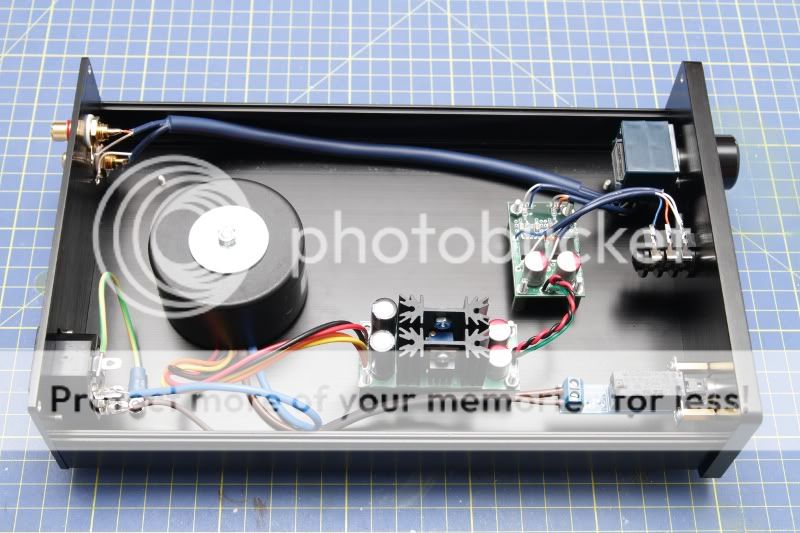
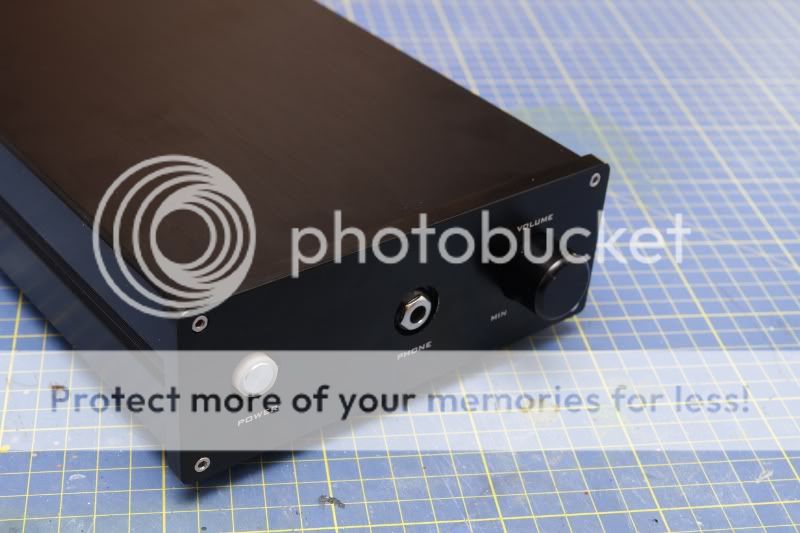
- Home
- Amplifiers
- Headphone Systems
- "The Wire" Ultra-High Performance Headphone Amplifier - PCB's
